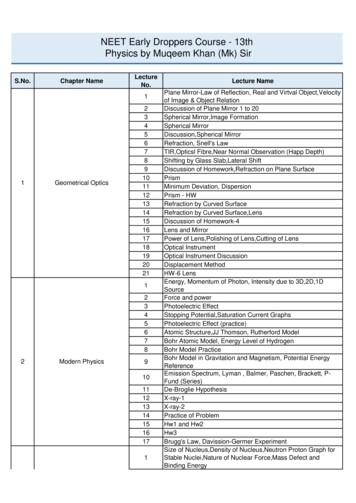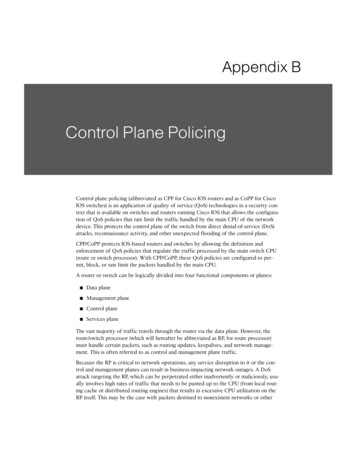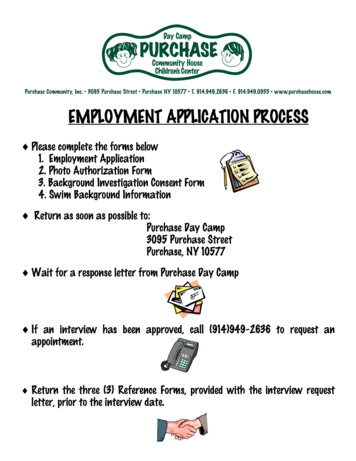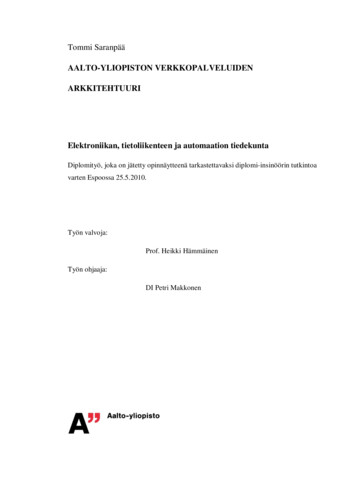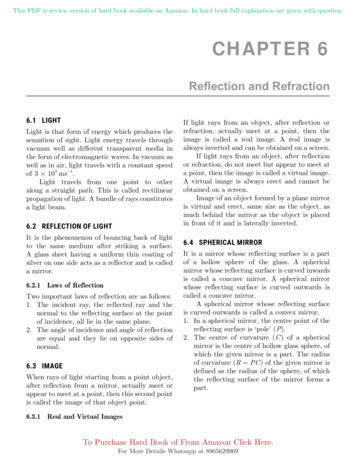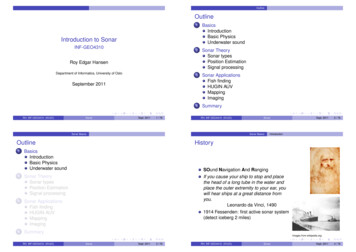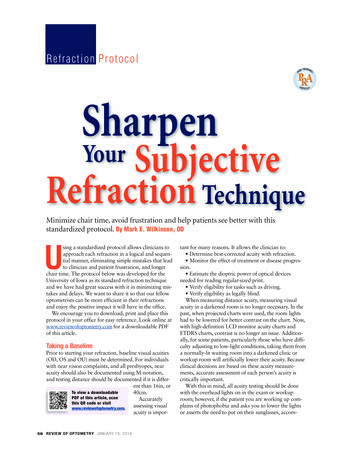
Transcription
Refraction ProtocolSharpenSubjectiveRefraction TechniqueYourMinimize chair time, avoid frustration and help patients see better with thisstandardized protocol. By Mark E. Wilkinson, ODUsing a standardized protocol allows clinicians toapproach each refraction in a logical and sequential manner, eliminating simple mistakes that leadto clinician and patient frustration, and longerchair time. The protocol below was developed for theUniversity of Iowa as its standard refraction techniqueand we have had great success with it in minimizing mistakes and delays. We want to share it so that our fellowoptometrists can be more efficient in their refractionsand enjoy the positive impact it will have in the office.We encourage you to download, print and place thisprotocol in your office for easy reference. Look online atwww.reviewofoptometry.com for a downloadable PDFof this article.Taking a BaselinePrior to starting your refraction, baseline visual acuities(OD, OS and OU) must be determined. For individualswith near vision complaints, and all presbyopes, nearacuity should also be documented using M-notation,and testing distance should be documented if it is different than 16in, orTo view a downloadable40cm.PDF of this article, scanAccuratelythis QR code or ty is impor-tant for many reasons. It allows the clinician to: Determine best-corrected acuity with refraction. Monitor the effect of treatment or disease progression. Estimate the dioptric power of optical devicesneeded for reading regular-sized print. Verify eligibility for tasks such as driving. Verify eligibility as legally blind.When measuring distance acuity, measuring visualacuity in a darkened room is no longer necessary. In thepast, when projected charts were used, the room lightshad to be lowered for better contrast on the chart. Now,with high-definition LCD monitor acuity charts andETDRS charts, contrast is no longer an issue. Additionally, for some patients, particularly those who have difficulty adjusting to low-light conditions, taking them froma normally-lit waiting room into a darkened clinic orworkup room will artificially lower their acuity. Becauseclinical decisions are based on these acuity measurements, accurate assessment of each person’s acuity iscritically important.With this in mind, all acuity testing should be donewith the overhead lights on in the exam or workuproom; however, if the patient you are working up complains of photophobia and asks you to lower the lightsor asserts the need to put on their sunglasses, accom-58 REVIEW OF OPTOMETRY JANUARY 15, 2016058 ro0116 F5 v3.indd 581/6/16 11:47 AM
Photo: Marc B. Taub, ODmodate them accordingly. Simply note that the recordedacuities were taken in conditions that deviated from thestandard.“Lights on” During RetinoscopyWhen doing retinoscopy, you will want the lightslowered; but, once you start your refraction, you willachieve greater accuracy when you refract with thelights on. Keeping the lights on during your refraction isimportant to avoid over-minusing your patients. Whensomeone is over-minused, the chart will look darker,which can be mistakenly thought of as looking clearer.Start off right with an objective determination of refractive error byretinoscopy.Pinhole Visual AcuityPhoto: Marc B. Taub, ODFor individuals without ocular disease, a pinhole aperture is a useful tool for determining if a refractive error ispresent or if a refractive change is needed. The most useful pinhole diameter for clinical purposes is 1.2mm. Thispinhole size is effective for refractive errors of /-5.00D.A pinhole improves visual acuity by decreasing the sizeof the blur circle on the retina, resulting in an improvement of the individual’s visual acuity; however, if the pinhole aperture is less than 1.2mm, the blurring effects ofdiffraction around the edges of the aperture will increasethe blur circle and cause worsened vision.Because the reduced amount of light entering throughthe pinhole makes the chart less clear for individualswith macular disease and other ocular diseases thataffect central vision, they may have the same, or evenreduced, acuity when looking through a pinhole. Itcan also be difficult to use eccentric fixation through apinhole. For this reason, individuals with ocular diseasemay still benefit from a spectacle correction change andshould not be toldotherwise basedsolely on their acuity when lookingthrough a pinhole.Careful retinoscopy,along with trialframe refraction, isneeded to determinewhether an individual with pathologyinduced vision losswill benefit from aspectacle correctionchange.Pinhole acuity is useful for patientswithout underlying ocular disease.Standard Subjective Refraction TechniquesThe goal of the subjective refraction is to achieve clearand comfortable binocular vision.The clinician’s ability to maintain control during therefraction is directly related to their ability to communicate clearly with the patient.The subjective refraction starts after retinoscopy orautorefraction, which provide the clinician with anobjective assessment of refractive error. It is possible tostart with the patient’s previous prescription; however,this is the least desirable way to begin, as there is noobjective information about the patient’s current refractive error. Thus, the best starting point is from the objective determination of refractive error by retinoscopy.Whether you start your refraction after retinoscopy, orwith autorefraction findings, you will first check acuityin each eye separately before the Initial Maximum Plusto Maximum Visual Acuity (MPMVA) step.Set up for Retinoscopy—Minus Cyl Phoropter Before putting the phoropter in front of the patient,clear the phoropter, set the cylinder axis at 180degrees and unocclude both eyes. After positioning the phoropter in front of thepatient, level the phoropter and make sure theinterpupillary distance is properly adjusted. Put either a group of letters or a fixation dot on thechart and direct the patient to look at the chart, notat you or your light. Ask the patient to tell you if your head blocks theirview of the chart.Retinoscopy For patients with an unknown refractive error,start with a vertically-oriented Plano mirror streak(sleeve up on Copeland and sleeve down on WelchAllyn) to streak the horizontal meridian.REVIEW OF OPTOMETRY JANUARY 15, 2016058 ro0116 F5 v3.indd 59591/6/16 11:47 AM
Refraction Protocol As you begin streaking the horizontal meridian, ifyour retinoscopic streak does not line up with theretinal reflex, rotate your streak until the streak andthe reflex are aligned. Continue streaking along thismeridian. Neutralize this meridian by adding plus lensesfor “with motion” or minus lenses for “againstmotion.” Once neutralized, rotate your retinoscope’s streak90 degrees from where your streak was previouslyaligned with the retinal reflex. Now, with this streak more horizontally oriented,streak the more vertically-oriented meridian. If your patient has no astigmatism, there will beno motion. Retinoscopy is completed for thiseye. If your patient has with-the-rule astigmatism,you will see “against motion,” which you willneutralize by adding minus cylinder axis 90degrees away from the initial meridian you neutralized. If your patient has against-the-rule astigmatism,you will see “with motion.” If this is noted, neutralize it by adding plus spherical power.* For against-the-rule astigmatism, after neutralizing this second meridian with spherepower, rotate the cylinder axis 90 degrees,back to the initial meridian.* Next, rotate your retinoscope’s streak backto this more vertically-oriented position. Youshould now see “against motion” in the morehorizontal meridian, which you will neutralize by adding minus cylinder. Once you have neutralized the right eye, do thesame for the left eye. When you have neutralized both eyes by retinoscopy, remove your working distance lens from eacheye (1.50D for a 66cm working distance or 2.00Dfor a 50cm working distance).Initial Maximum Plus to Maximum Visual Acuity Next, occlude the left eye, put several lines of letters on the eye chart, such as 20/20 to 20/50 or20/15 to 20/40, and ask the patient to read thesmallest line they can. Assuming the patient can read the letters being presented, begin by adding 0.75D to the phoropter.This should result in the loss of two to three lines ofvision. If there is no loss of vision, add another 0.75Dand make sure there has been a decrease in visionby two to three lines from your starting point. Next, slowly decrease the power in the phoropter(less plus or more minus), in 0.25D steps, untilthe patient is able to see the 20/20 or 20/15 lines,or until there is no further improvement in vision.Expect about a one-line improvement on the eyechart for every -0.25D added. Once you have achieved the initial maximum plusto maximum visual acuity, the patient’s cylindricalcorrection can be refined.Refining Cylinder/Axis and Power Swing the Jackson cross-cylinder (JCC) in front ofthe patient’s eye to refine cylinder axis and power. As a general rule, if the patient’s refractive error isprimarily cylindrical, or if by retinoscopy or autorefraction you found 1.00D of cylinder or more, startby checking the cylinder axis first. Otherwise, startby checking the cylinder power. To check the cylinder axis first, position the JCC sothat the white and red dots straddle the cylindricalaxis by 45 degrees on either side. Have the patient look at either a single line of lettersone line larger than their best visual acuity foundduring the initial MPMVA, or the same grouping ofletters you started with.Reading the Fine PrintIt is important to know that when doing near acuity testing,reduced Snellen acuity is only accurate at a fixed testing distance, which is 40cm for most near acuity cards.You should also know that Jaeger numbers have no precisemeaning. Jaeger numbers refer to item numbers in a printingcatalog in Vienna in the 1850s. The International Council ofOphthalmology has stated that the lack of external definition ofJaeger numbers makes them extremely variable. With this inmind, Jaeger numbers should not be used for near vision testing.The preferred method for near acuity testing uses the M-unit,which is the only letter size unit that is well defined. A 1M lettersubtends five minutes of arc at 1M. For reference purposes, a1M-sized letter is equivalent in size to newsprint, while 2M isequivalent in size to standard 18-point large print and 0.5M isequivalent in size to print half the size of newsprint.When measuring near visual acuity, the patient will use theirreading correction. Have the patient hold the reading card attheir normal reading distance. The clinician should note errorsrelated to scotomas and visual field loss. Near acuity is recorded as M-units at the testing distance (e.g., 1.25M at 40cm).Measuring visual acuity at each clinic visit is standard of care.Documentation of visual acuity is important to defend againstan accusation that a procedure or treatment harmed vision.60 REVIEW OF OPTOMETRY JANUARY 15, 2016058 ro0116 F5 v3.indd 601/6/16 11:47 AM
Refraction Protocol Tell the patient, “I am going to give you two choices. With your JCC oriented for power at 90 and 180Neither will be perfectly clear; however, I want youdegrees, ask the patient, “Which is better: choiceto tell me which lens choice is clearer: choice one orone or two?”choice two; choice three or choice four? And so on.” If the patient indicates no preference, repeat at 45 Be sure to use fresh choices and new numbers withand 135 degrees.each pair you present. If the patient indicates a preference, add -0.50 Move the axis in the direction of the red dot, inicylinder at the axis where the red dot is oriented,tially in 15-degree increments, for individuals withalong with 0.25D sphere power to maintain the2.00D of cylinder or less. You will decrease thespherical equivalent.increment size following a reversal by 15-10-5-3-1 Using the standard JCC technique described above,degrees as the axis is refined.refine the cylinder power and axis. For individuals with more than 2.00D ofFavorite Phrasescylinder, start with 5-degree increments, During the subjective portion of the refraction say, “I am going to have you lookdecreasing the increment size following athrough two different lenses. Although neither lens may be perfect, I want youreversal by 5-3-1 degrees until the axis isto tell me which one looks clearer.”refined. When the patient becomes indecisive, remember to add, “ or do they look the To check cylinder power, adjust the posisame?” Reassure them that it is OK to think the choices look about the same.tion of the JCC so that the white or reddots correspond with the cylinder axis. Ask the patient, “Which lens choice is clearer: choice Second Maximum Plus toone or choice two?”Maximum Visual Acuity If the patient chooses the white dot, subtractThis step is performed when the cylinder power has-0.50D of cylinder power while remembering tochanged by 0.50D or more, or if the cylinder axis hasadd -0.25D of spherical power to maintain thechanged by 10 degrees or more during cylinder powerspherical equivalent.and axis refinement. If the patient chooses the red dot, add -0.50D Begin by adding 0.50D to the phoropter. Theof cylinder power and add 0.25D of sphericalpatient should lose about two lines of vision. If thepower to maintain the spherical equivalent.acuity is the same or better, add another 0.50D Once the patient reverses (i.e., chooses the reduntil the vision is blurred by one to two acuity lines.dot after previously choosing the white or vice Next, slowly decrease the power in the phoropter inversa) adjust the cylinder power by 0.25D in the0.25D steps until the patient is able to see the 20/20opposite direction of your previous change. Theor 20/15 line, or until there is no further improvespherical power does not need to be adjusted forment in vision.this 0.25D change. Occlude the right eye while unoccluding the left. Once more, check the cylindrical power with theRepeat the same process for the left eye, beginningJCC to see if the patient wants more or less power.with the Initial MPMVA.The goal is to give the least amount of cylindricalpower that provides the clearest vision.Binocular Balance When the cylindrical power and axis have beenOnce the monocular subjective refraction has been comrefined with the JCC, remove the JCC from in frontpleted for each eye, it is time for the binocular balance.of the patient’s eye and ask the patient to read theBinocular balancing is only done when the visual acuitysmallest line they can.is relatively equal between the two eyes. Remember, if the starting cylinder power is 1.00DBinocular balancing can be accomplished in two difor greater, check the cylinder axis first. You will only ferent ways: using the Risley prism on the phoropter orcheck the cylinder power first for cylinder powersby alternate occlusion (described on the next page).less than 1.00D. In either case, you should start the binocular balancing procedures by adding 0.75D sphere to botheyes so that the patient’s visual acuity is blurred toCylinder Power Searchthe 20/30 to 20/40 levels. By slightly blurring visionIf retinoscopy or autorefraction indicated no cylinderin this way, eye dominance is effectively neutralwas needed and you suspect otherwise, do a cylinderized during the balancing process. It is important topower search.REVIEW OF OPTOMETRY JANUARY 15, 2016058 ro0116 F5 v3.indd 63631/6/16 11:48 AM
Refraction ProtocolPhotos: Marc B. Taub, ODmake sure the patient is mildlyblurred before using the Risleyprism or alternate occlusion binocular balancing techniques.Risley Prism Binocular BalancingTechnique Using the Risley prisms, applythree prism diopters base up infront of the right eye and threeprism diopters based down infront of the left eye. This willresult in the right eye seeing thelower image and the left eye seeLeaning to see the chart better while in a 10-foot exam room can be equivalent to aing the upper image.one-line or more improvement in vision. For the sake of accuracy, the patient should Asking the patient to ignoresit back in the exam chair—no leaning forward.brightness differences (this canbe confusing for some patients), If the letters on the green side of the chart appearhave them tell you which image appears clearer.blacker, add 0.25D. If the letters on the red sideAdd 0.25D to the clearer eye to fog it further.of the chart appear blacker, add -0.25D. Again ask the patient which image is clearer and The endpoint is reached when the letters appearadd 0.25D to the clearer eye.equally black on both the red and green side. It is The endpoint is reached when either both sets ofimportant to ask the patient to tell you on whichletters look the same or when the dominant eyeside the letters look “blacker,” not on which sideappears slightly clearer than the non-dominant eye.they look “clearer” on.Alternate Occlusion Technique After fogging the patient, alternately cover one eyeand then the other, while asking the patient whicheye sees the chart more clearly, eye one or eye two.To avoid confusion, say “eye one” or “eye two”rather than “right eye” or “left eye” while you alternately occlude. Add 0.25D to the clearer eye to fogit further. The endpoint is reached when both sets of letterslook the same or when the patient’s dominant eyeappears slightly clearer than their non-dominant eye.Determining the Final Correction Once the binocular balance is completed, add-0.25D OU one step at a time to bring the patientback to their best visual acuity. Remember, youshould expect about one line of improvement invision with each -0.25D addition. Do not give additional minus spherical power without an improvement in acuity.Duochrome TestThe duochrome (red-green) test can be used as a monocular or binocular test to determine the proper spherical power.Refracting in a Shorter RoomShorter examination rooms are common outside ofpediatric practices. A shorter room is considered a roomless than optical infinity, which is 20 feet or 6m. It isimportant to recognize that when refracting in a shorterlane, vergence and accommodation are in play.To calculate vergence, use the formula 1/x (m),or 100/x (cm) or 40/x (in). Given this, the vergencedemand in a 10-foot exam room is 40/120 0.33D.Therefore, when testing acuity in a 10-foot lane, thepatient is effectively getting an extra -0.33D of refracting power from the shorter room. With this in mind,for every patient refracted and focused at infinity in ashorter exam room, additional minus power needs to beadded to what was found in the phoropter. For example, add -0.25D for a 10-foot exam room. Add -0.50Dfor a six-foot exam room.Consider what happens when testing visual acuity ina shorter exam room. In a shorter room, the patient isgetting, at the least, an extra -0.25D of improvement intheir vision on the eye chart. This is why someone canhave 20/20 2 entrance acuity and still need an extra-0.50D in his or her final prescription to see with 20/15acuity. Be aware that the acuity charts in shorter examrooms are adjusted to the correct letter height for the64 REVIEW OF OPTOMETRY JANUARY 15, 2016058 ro0116 F5 v3.indd 641/6/16 11:48 AM
room’s testing distance, so the visual acuity measuredin a shorter exam room is the correct acuity.Finally, with respect to visual acuity testing, it isimportant to understand that when a patient leans in tosee the chart better, the testing distance can be 12 to 20inches less. A lean of 16 inches while in a 10-foot examroom is equivalent to a one-line improvement in vision.For the sake of accuracy, it is important to have thepatient sit back in the exam chair—there should be noleaning forward in an attempt to see the chart better.Cardinal Rules of Refractionrefractive error will help you stay on target with yourrefraction. Keep it simple—avoid needless detail or jargonwhen describing what you are doing. Maintain your patience—to avoid frustration, goslowly when needed and try to make the choices as easyas possible. Provide encouragement—particularly when working with patients who are hard to refract. Proceed with a purpose—do not offer more choicesthan are necessary to establish your endpoint. Boredomand fatigue can result in poor subjective responses.Our ultimate goal is to make both images looked thesame, yet we continually are asking the patient to determine which is better, knowing that the decision getsharder as we get closer to our goal of equality. The principles below will help avoid frustration for both doctorand patient: Refraction is both an art and a science. Given this,it is important to know that patients do not alwaysrespond accurately during testing with the Jackson crosscylinder and during duochrome testing. This is whystarting with an objective assessment of the patient’sThough optometry has made enormous strides inexpanding its scope of practice, refraction is its lifeblood.Such an inherently subjective experience is never goingto be as precise as we may hope, but adopting a standardized protocol such as this will help remove some thevariables that lead to suboptimal results. Dr. Wilkinson is a clinical professor in the department of ophthalmology and visual sciences at the University of Iowa’s Carver College of Medicine. He is alsodirector of the institution’s vision rehabilitation service.20 Troubleshooting Tips for ‘Eyeglass Checks’What do you check for when a patient complains that their new glasses are not as good as their previous pair? Consider these 20 tips.1. Ask about complaint specifically. Is it distance? Near?Asthenopia? Diplopia? Pain behind the ears or at the bridge of thenose from ill-fitting glasses?2. Read the new and old glasses on the lensometer and compare.3. If you feel the prescription is reading differently than prescribedon an automated lensometer, check the prescription on a manuallensometer to be sure.4. Remember that digital lenses, particularly digital progressivelenses, will not measure exactly to the power prescribed. This isbecause digital lenses are designed to adjust to the different vertexdistances the patient will have when viewing through different partsof the lens.5. Make sure the old glasses did not have any prism.6. Check the patient for undetected strabismus with cover testing.7. Refract the patient again, possibly with a cycloplegic agent, if thesymptoms warrant.8. Check the optical centers in comparison to the pupillary centers.9. Check whether the reading segments are in the correct position.10. Make sure the new glasses fit the patient correctly.11. Check whether the old glasses were made in a plus cylinderdesign using the Geneva lens clock.12. Check whether the base curve was changed using the Genevalens clock.13. Evaluate the patient for dry eye.14. If the patient has a high prescription, check the vertex distance.Often, it is easier to refract such patients over their old pair ofglasses to keep the vertex distance the same.15. Check the pantoscopic tilt. Normally the tilt is 10 to 15 degrees,so that when the patient reads, the eye is perpendicular to the lens.The patient may be noticing that the tilt is different compared to theold glasses.16. With postoperative glasses, evaluate for diplopia in down gazedue to anisometropia.17. The add may be too strong or too weak. Check the patient usingtrial lenses and reading material.18. Sometimes, if the diameter of the lens is much larger in thenewer frame, the patient may be noticing distortion in the periphery of their lenses. In this situation, encourage a smaller frame.Conversely, if the new frame is significantly smaller, the patient maynotice the edges of the lenses, or the reading area of their multifocallens may be too small to use efficiently. In this situation, encouragethe use of a larger frame.19. Above all, try to test the new prescription in a trial frame with awalk around the office; you do not want to go through this processagain.20. If you can find nothing wrong with the Rx and the optics of thelenses, encourage the patient to give the glasses another try. Anadaptation period may be necessary, especially for progressives.REVIEW OF OPTOMETRY JANUARY 15, 2016058 ro0116 F5 v3.indd 65651/6/16 11:48 AM
degrees away from the initial meridian you neu-tralized. If your patient has against-the-rule astigmatism, you will see "with motion." If this is noted, neu-tralize it by adding plus spherical power. * For against-the-rule astigmatism, after neu-tralizing this second meridian with sphere power, rotate the cylinder axis 90 degrees,


